Features of growing and useful properties of red onions
Red onions will decorate any dish and will serve as a prophylactic against vitamin deficiency, colds and many other diseases. It actively stimulates digestion, has antiseptic, tonic, anti-inflammatory and antioxidant properties. Growing a culture and caring for it does not require much time and effort. However, it is important to know the important features of red onion cultivation.
The content of the article
Description of the species
Red onion is a type of onion... Its main characteristics are its unusual skin color and a sweeter taste than regular onions. The pulp remains white.
Turnips are small in size, soft, juicy and tender on the palate... There is no characteristic bitterness. Depending on the variety, the vegetable is sweeter or less.
Homeland red onion - Middle Asia... Later, the employees of the Nikitsky Botanical Garden in Crimea made a great contribution to the emergence of new varieties with excellent taste characteristics.
Varieties
Most of the plants are found in the middle climatic zone.
They are divided into the following groups:
- sweet - suitable for food even for children (from an adequate age);
- peninsular;
- spicy - have the sharpest taste.
Consider popular varieties of red onions with description and photo.
Crimson ball
Early maturing culture: the crop is harvested 80–95 days after sowing... Dark purple vegetables of regular rounded shape are formed in 1 season.
The average weight of the bulbs is 80–90 g. The taste is semi-sharp.
The shelf life of the crop is short: only 4 months.
Greatful Red F1
The ripening time of the hybrid is average: 125 days from the date of sowing... Marketable yield is high: 276-650 centners are harvested from 1 hectare. In the Volgograd region, 850 c / ha were obtained. The culture is recommended for cultivation in the Lower Volga region.
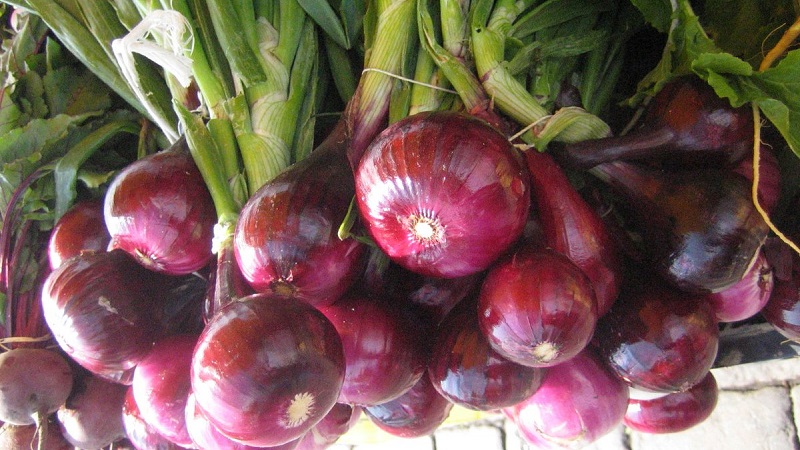
Large dark red bulbs weighing up to 120 g... The taste is semi-sharp and juicy.
Important! After ripening, the vegetables ripen completely.
The hybrid is resistant to fusarium rot... Possesses high keeping quality (stored until March).
Campillo F1
The hybrid produces rounded bulbs, soft purple in color with a mild taste... It grows both in the south and in central Russia.
Ripening periods are medium late (up to 150 days after planting).

Resistant to pink rot and fusarium... The harvest is stored without loss of taste until the next season.
Retro
The variety is late-ripening: 150 days pass before harvesting after sowing... Recommended for the Central Region. The bulbs are dark red with white juicy pulp. It tastes sweet. Up to 280 centners of vegetables are harvested from 1 hectare.
Stored for only 3-4 months. Retro is resistant to fusarium and onion fly.
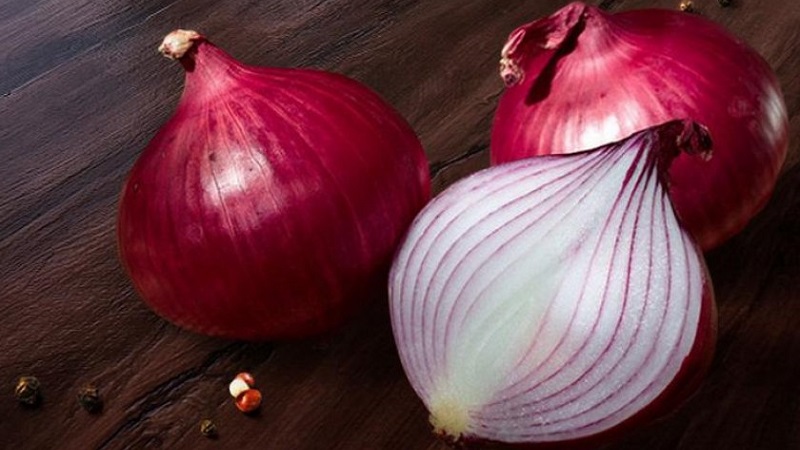
Yukont
Early variety: 85 days pass from sowing to full ripeness... Suitable for growing in the following regions:
- Central;
- Central Black Earth;
- Volgo-Vyatsky;
- Ural;
- West Siberian.
The bulbs are round, red with purple outlines... The taste is spicy.
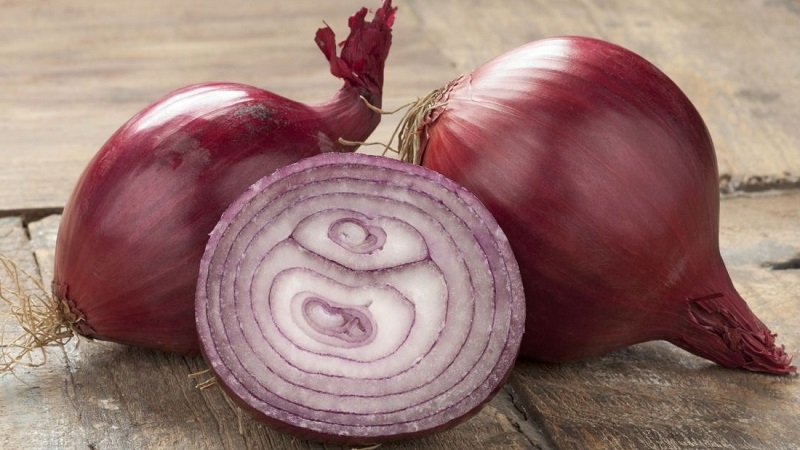
In an annual crop in the Central region, up to 210 c / ha of yield are harvested, in the Central Black Earth - up to 120 c / ha, in the Ural - 212 c / ha, in the West Siberian - up to 300 c / ha. Vegetables are stored for up to 8 months.
Important! When grown from seeds, onions are harvested after a year, from seedlings - after 2.
The variety is resistant to fungal diseases.
Yalta
Most popular variety red onion, since suitable for cultivation in all regions... Ripening time is average: up to 130 days from the day of sowing.
Bulbs are wide red... The pulp is juicy and white, sweet in taste.
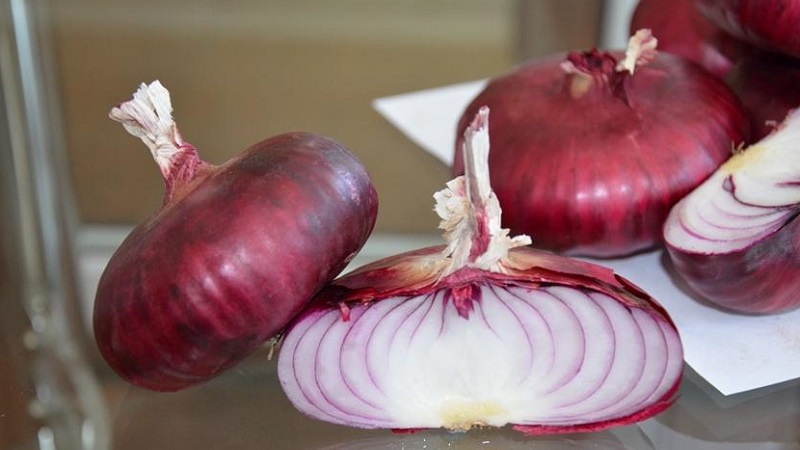
Yield Yalta onion high: from 1 hectare harvested up to 500 centners. The culture is susceptible to onion fly attacks.
Chemical composition
The composition of red onion contains such useful elements:
- boron;
- cellulose;
- sulfur;
- iron;
- iodine;
- calcium;
- potassium;
- magnesium;
- sodium
- fluorine;
- chromium;
- chlorine.
The vegetable has a low calorie content.: 40 kcal per 100 g.
There are anthocyanins in the pulp and juice - colorants, flavonoids, which reduce inflammation, prevent cell damage during oxidation in the intestine.
Onions contain phytoncides - substances that have a detrimental effect on pathogenic fungi and microorganisms.
Bulb characteristics
The whole bulb, except for the roots, is used for food.
Important! Some varieties have multi-layered feathers and reach a height of 1.5 m.
The turnip, depending on the variety, is wide, round or oval... Consists of numerous layers of juicy scales. The color changes from pale red to purple.
Advantages and disadvantages
The main advantages of red onions:
- great content nutrients;
- many varieties are suitable for growing in almost any region;
- mild taste without bitterness;
- high productivity and keeping quality of some varieties.
Vegetables are picky about picking times and storage conditions.

Onions are not eaten when:
- kidney disease;
- violations in the liver;
- intestinal inflammation;
- stomach ulcer;
- individual intolerance;
- pregnancy;
- breastfeeding.
Differences from other types of onions
The main feature of red onions is the color of their husks.... It comes in both pale pink and rich dark shades. Almost all varieties have excellent taste, juicy, delicate and sweet.
Some plants (for example, Greatful Red) have increased keeping quality and resistance to transportation, while others (Campillo) have a strong immunity to diseases.
Useful properties of red onions:
- Anti-inflammatory - helps the body fight inflammation, infections.
- Antiseptic - disinfects the skin, kills pathogenic bacteria.
- Secretory - promotes the production of acid in the stomach.
- Anthelmintic - makes the habitat of parasites unfavorable.
The vegetable improves blood circulation, dilates blood vessels... Thanks to its high sulfur content, it improves the condition of skin, hair and nails.
Take a note:
Features of planting and growing
The culture is demanding on light and humidity... The richest harvest of large bulbs ripens in sunny, well-damp areas.
Is it possible to plant on the head before winter
Although red onions prefer warm climates, some varieties (for example, Robin, Black Prince) are planted before winter.
Sowing times vary by region: in the southern regions it is November, and in the northern regions it is September. The suitable ground temperature does not exceed + 5 ° C.
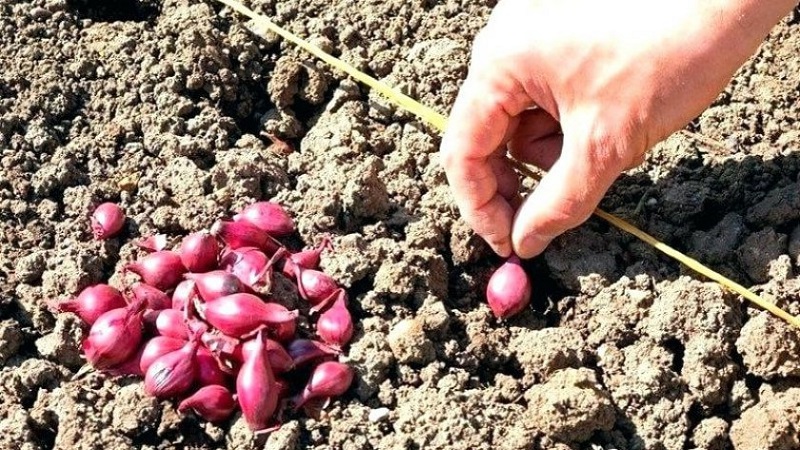
Planting technology for the winter:
- Choose an open, sunny area with well-drained soil. The earth is dug up with humus, mineral fertilizers, ash.
- As soon as the soil settles, the area is leveled with a rake, furrows are made 6 cm deep.The distance between them is 20 cm.
- Sevok is planted 8 cm apart.
- The soil is sprinkled and compacted.
- Water only after 10 days.
- As soon as frost sets in, the ground is mulched with straw.
Some gardeners plant several varieties at once in order to choose the one they like and prepare it for next year. This procedure will help determine the most winter-hardy onion.
Preparing for landing
The planting material is pre-soaked in a weak solution of potassium permanganate (pink) for 30 minutes. This will kill the pathogens. To accelerate germination, the seedlings are treated with a growth stimulant and placed in a canvas bag.
Ground requirements
The site for planting is chosen well-lit, with fertile soil. (pH is 7). If the soil is acidic, add dolomite flour.
Attention! The culture grows best in the place where cabbage was before.
The following fertilizers are applied for digging (based on 10 liters of water):
- urea - 2 tbsp. l .;
- rotted chicken droppings - 100 g;
- manure infusion - 1 l.
Timing, scheme and landing rules
The prepared material is planted in open ground 2 days after processingwhen constant warm weather is established (+ 22 ... + 23 ° C), and the soil warms up well.
Planting depth: 1.5 cm. Scheme: 3x10 cm.
Sevok is planted in furrows 5 cm apart... The distance between the furrows is 24 cm.
Growing features
Early-maturing varieties are cultivated in northern latitudes... For planting, use seedlings or seedlings. These vegetables have a bitter taste.
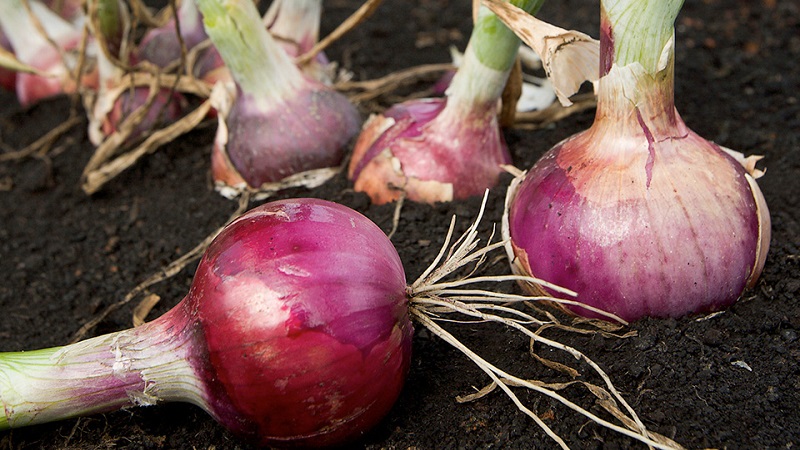
For the central strip, onions with medium ripening times are suitable.... Sevok is taken as planting material.
In southern climates, on fertile soil, all varieties grow... The taste of such onions is sweet or semi-sweet.
The nuances of care
Red onion care standard. Watering is carried out as the topsoil dries up, top dressing - 2 times per season.
Advice! For long-term storage of the crop, the feathers of the plants are not cut off.
Watering mode
Red onions are watered once every 7 days, at the rate of: 5-10 liters of water per 1 m2... At the same time, they pay attention to the weather conditions. If the summer is dry, and the feathers begin to dry, the frequency of irrigation is increased to 2 times a week. In rainy weather, watering is stopped.
In July, when the turnips begin to ripen, the culture is moistened once every 14 days.
Stop watering completely 2 weeks before harvest: vegetables are allowed to dry out so that they do not rot during storage.
Loosening and weeding
Loosen the earth shallowuntil the stems closed.
Weeding is carried out regularly: Weeds take nutrients from the plants.
Top dressing
Fertilize the crop twice a season:
- When forming bulbs, organic compounds are used. Prepare a solution of chicken manure (1:10) or liquid mullein (1: 5).
- At the end of June, a composition of 10 liters of water, 60 g of superphosphate, 30 g of sodium chloride is introduced at the root. The resulting volume is enough for 2 m2.
Disease and pest control
Most often, red onions are exposed to a fungal disease - fusarium... It manifests itself by softening the bottom of the head and the death of the roots. The leaves turn yellow and the plant dies. The affected bushes are not subject to treatment - they are dug up and burned. For prophylaxis, the seedlings are soaked in fungicide for 30 minutes before planting.
In dry summers, plants are attacked by onion flies.... It appears as soon as dandelions begin to bloom. Insect larvae penetrate the vegetable through the bottom or base of the leaves, eating it from the inside. To combat the pest, tobacco is used. It is mixed with water at the rate of: 250 g per 10 liters, insisted for 2 days. The resulting product is sprayed with plants. 1 m2 you need 1 liter of composition.
Harvesting and storage
Red onions are picky about harvesting times and storage conditions. It is much more difficult to store it than regular bulbs..
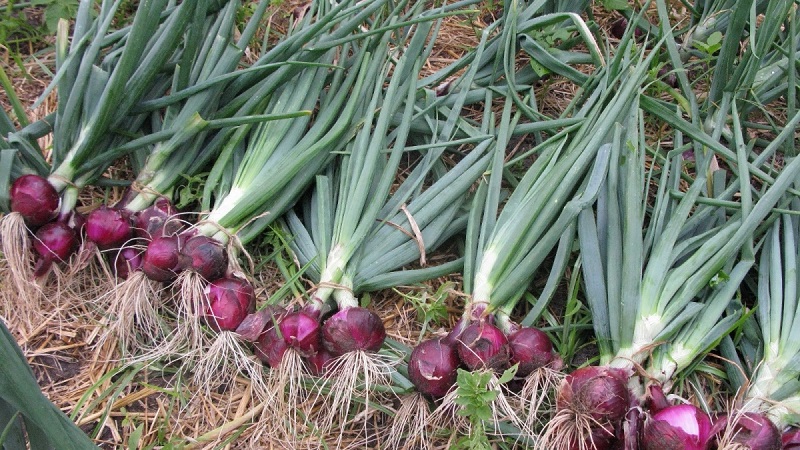
Vegetables ripen in late July - early August... Once the neck is dry and most of the feathers turn yellow and dry, the onion is ready.
Attention! Harvesting is carried out in warm sunny weather.
Store red onions in boxes or on special racks... Room humidity should be about 65%, temperature should not be higher than + 19 ° C.
Varieties of this variety have a high keeping quality.... Some (Greatful Red, Campillo, Yukont) are kept until the new season.
Growing difficulties
Germinating red onion seeds for seedlings is the main difficulty that vegetable growers face.
The seeds have low germination. To increase it, the material is pre-prepared:
- disinfected in a weak solution of potassium permanganate (30 minutes);
- treated with a biostimulator "Epin" (at least 18 hours);
- carefully select a place for seedlings.
Tips from experienced gardeners
Experienced farmers give some recommendations for growing this variety of onions:
- It is better to approach the choice of a variety based on the region of cultivation. The taste of vegetables and shelf life depend on this.
- To get sweeter and larger bulbs, the crop is planted in fertile soil.
- They store turnips in stockings or tights. The material will protect the crop from excessive moisture and provide air flow.
Reviews
Red onions are popular with farmers in various regions. His grown both for food and for the manufacture of cosmetics.
Anna, Krasnodar Territory, Yeysk: “I plant Yalta onions in the garden along with carrots. The harvest turns out to be strong, it lies for a long time. I use it for making salads and preserves ".
Victor, Moscow region, Krasnoarmeysk: “I have been growing the Red Baron variety for 2 years now. The turnips are large and dense. Perfect with kebabs and fish. The yield is very high, and the culture is unpretentious to care ".
Daria, Vladimir region, Alexandrov: “I use red onions not only in cooking, but also for the preparation of various cosmetics: hair masks, decoctions. The smell is not as persistent as that of white. The effect is amazing ".
Conclusion
Red or purple onions are a common type of onion. The culture is unpretentious in care, suitable for growing in the southern, middle and northern regions of the country. Vegetables have a pleasant sweet taste, so they are added to various dishes, especially salads.
Due to its rich chemical composition, the plant is effective against colds, improves blood circulation, reduces blood pressure and speeds up metabolism. In cosmetology, masks, decoctions and infusions are made from it.